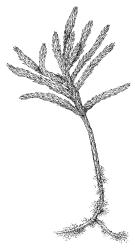Elements in the following description are translated from Brotherus (1925).
Plants robust, gregarious, dendroid, bright green to bronze, weakly glossy. Primary stems subterranean, rhizomatous, beset with scale-like and erect leaves and red-brown, smooth rhizoids. Secondary stems erect, with a well-developed stipe and frond, rarely unbranched or ± pinnately branched, with apex concealed or shortly protruding beyond apical branches, densely covered below with red-brown rhizoids, in cross-section ± angled, with several layers of thick-walled cortical cells and a central strand. Branches mostly simple, rarely ± pinnate, densely leaved, often unequal in length, tapered apically. Stipe leaves erect-appressed when moist, broadly ovate and cordate, sharply or bluntly mucronate, obscuring the stipe. Branch leaves erect-spreading when moist, little altered when dry, lanceolate-lingulate, acute, from an auriculate and ± decurrent base, weakly or markedly sulcate, serrate above; upper laminal cells smooth, narrowly rhomboid, moderately thick-walled, those below more linear and porose and orange near leaf base; alar cells lax, hyaline and thin-walled, forming a large and well-defined group. Costa single and strong, ending below the leaf apex, sometimes with few to several abaxial teeth near apex. Paraphyllia abundant, filiform or much-branched.
Dioicous. Perichaetia numerous, on secondary stems and at branch bases, elongate and slender, with leaves erect and sheathing, the innermost abruptly narrowed to a narrow apex, entire, and shortly costate. Perigonia on secondary stems and branch bases, bud-like, with numerous antheridia and elongate brown paraphyses. Setae single or aggregated, elongate, purple, twisted to the right above; capsules erect and symmetric, ± cylindric, smooth, red-brown; stomata numerous, small, confined to the neck; annulus lacking; operculum rostrate from a conic base, falling with the columella attached. Peristome double; exostome teeth fused at base, linear-lanceolate, dark red-brown, bordered, closely articulate, coarsely papillose on the outer surface, the inner surface with numerous and conspicuous lamellae; endostome yellow or orange, arising from a very low membrane, segments linear, broadly perforate along the median line, and apically forked. Calyptra narrowly cucullate, split to the apex, smooth, enclosing the entire capsule. Spores 15–28 µm, rust-coloured, finely granular.
| Category | Number |
|---|---|
| Exotic: Fully Naturalised | 1 |
| Total | 1 |
A genus of three species distributed in temperate northern hemisphere and adventive in Australasia. The species of Climacium grow primarily in swampy habitats.




